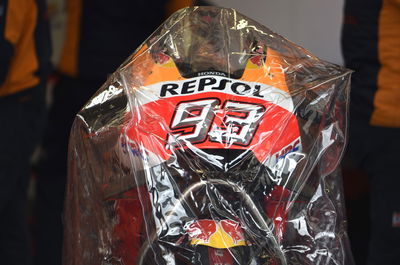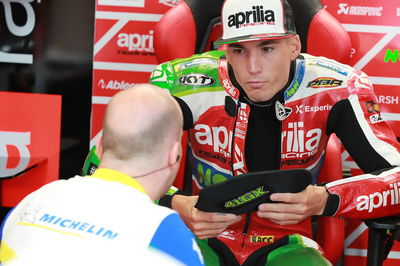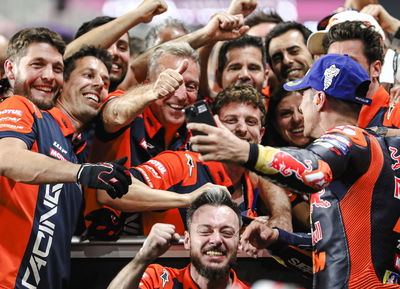Race Direction explains British MotoGP schedule change
Mike Webb, MotoGP Race Director, has explained the thinking behind Sunday’s schedule change for the British Grand Prix and stated he will do everything within his means to ensure all three races are run. However, “if everything is against us,” he warned, “there is a small possibility we’ll have to cancel races.”
After a terrifying incident in FP4 left Tito Rabat nursing serious fractures in his right leg due to standing water on the Hangar Straight, many MotoGP riders stated it would be difficult to race in similar conditions that Webb said were not normal.

Mike Webb, MotoGP Race Director, has explained the thinking behind Sunday’s schedule change for the British Grand Prix and stated he will do everything within his means to ensure all three races are run. However, “if everything is against us,” he warned, “there is a small possibility we’ll have to cancel races.”
After a terrifying incident in FP4 left Tito Rabat nursing serious fractures in his right leg due to standing water on the Hangar Straight, many MotoGP riders stated it would be difficult to race in similar conditions that Webb said were not normal.
With heavy downpours forecasted around lunchtime on Sunday, organisers have moved to re-work the schedule. The premier class race will now open proceedings at 11:30 with Moto3 and Moto2 following later in the afternoon, with Webb stating the smaller machines are less inclined to aquaplane than the heavier, more powerful MotoGP machines.
"Normal rain in normal quantities” should not pose any problems around the recently resurfaced track, said Webb. But issues could arise in case of “very short, heavy rain,” the type of which is unfortunately forecasted for just after noon tomorrow and throughout the afternoon.
“The schedule for tomorrow has changed to basically swap Moto3 and MotoGP, which means MotoGP runs first,” explained Webb. “It’s due to the very strong possibility of rain as the day goes on. From the Met Office we’re getting quite a significant possibility of heavy rain.
“What we saw today on track was a particular problem in two places of the circuit with standing water staying after heavy rain. In normal rain conditions it’s actually pretty good. There is no real problem. But as you saw in FP4 today, the conditions are basically ‘unrideable’.
“I would say that on a MotoGP bike in every circuit we go to the biggest problem we have is standing water and that’s always bigger for MotoGP because of the size of the tyres and the speed they’re running. In conditions a lighter, smaller bike might be OK, but a MotoGP bike might be ‘unrideable’.
“At the request from the promoter, from Silverstone, to ensure there is a MotoGP race, we’ve agreed to change the schedule to make MotoGP go first to at least give us a chance to have a MotoGP race completed.
“If we go back to Friday, when we had a wet Moto2 session, there was normal rain, in normal quantities, the circuit is fine and the grip is good. We didn’t have any major problems. In those circumstances we can have a race in any class.
“The very short, very heavy rain that we had in half of the circuit in FP4 today – and just in that place – the circuit couldn’t cope. We’re working tonight on drainage solutions. In one place that might be OK. In the other, where the crashes occurred, there is limited work that we can do because of the limited shape of the surface and where it funnels the water.
“We’ll do everything we can. In normal rain circumstances we’re fine. If the heavy rain that is forecast does hit, we will probably not be able to race.”
Webb did go on to stress that the chances of this are a “small possibility” – “You have seen us doing this before,” he insisted, “reacting to bad conditions in strange races, where we’ll do everything we can to run the races: rescheduling, running later depending on daylight.
“I’m just raising the possibility that, if everything’s against us like the weather and running out of time, there is a small possibility that we’ll have to cancel races. We’ll do everything we can to avoid that.”
Several riders pointed to the 3.6-mile track’s new surface and an inability to effectively drain water in instances of heavy downpours as the principle problem. The new tarmac has succeeded in providing riders with more grip, and is certainly more consistent than what they encountered a year ago.
However Webb explained the camber on the run to Stowe corner has been slightly altered, making rain water collect in the middle of the track in a crucial braking zone. Another problem spot is on the entrance to Vale with excessive water collecting in the middle of the track. And, going off rider feedback, the bumps are even more pronounced in 2018 than previous years.
“It would have to be [the new surface causing this issue],” he said. “What used to be a very inconsistent surface all around the track with some significant bumps in significant places now is a consistent surface. But in doing that inevitably the camber has changed in some places.
“We’re seen at the entry to turn eight [Vale] and especially the entry to turn seven [Stowe] – they’re places where the surface has changed so the water collects right in the braking area. So it’s an unfortunate set of circumstances that those two areas exist. We have to fix it but it can’t be done overnight.”
Will this be addressed before next year’s event? “Yes,” he said, “because in any race you can expect rain. We even see rain in Qatar. You can expect rain but the surface has to be ready for it.
“We have this problem in many circuits and it gets fixed. This is the first time we’ve raced here with the new surface. We found a couple of places that are difficult. It can be fixed and it will be. Now our focus is we can get through tomorrow.”
As the heavy showers are forecasted to arrive around noon, Webb was asked why the MotoGP race was not scheduled to begin even earlier. Having discussed the matter with premier class teams, Webb revealed 11:30 was the earliest time they could begin with the necessary preparations after morning warm-up.
“The decision was arrived at together with the teams. Before any decision was made we sat down together with the teams to get their thoughts and this is what we’ve arrived at. They were prepared and quite happy to go along with a schedule for earlier. We suggested earlier warm-ups, shorter warm-ups, anything to get the race underway earlier.
“The consensus of the teams was, no, this was the schedule they wanted. They are very constrained with time between warm-up and the race – preparation time – and also the time of day to start warm-up. So this is what we’ve agreed to.”











